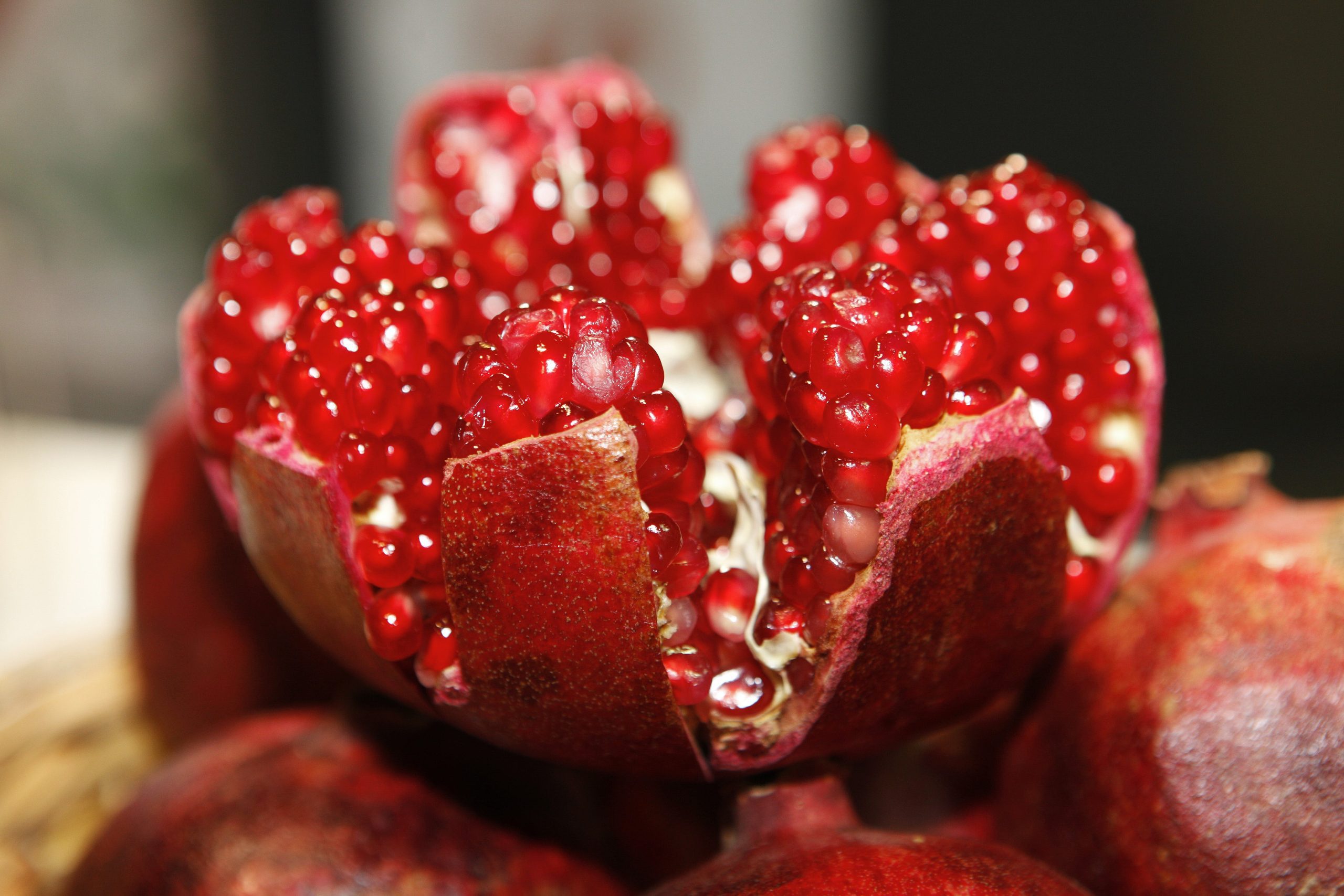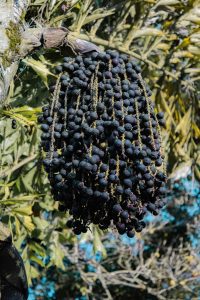
What Is a Pomegranate?
A pomegranate is a fruit that belongs to the Punica genus and is primarily known for its distinctive appearance and the numerous seeds encased in juicy, edible arils. Scientifically named Punica granatum, the pomegranate is native to the Middle East and has been cultivated for thousands of years. It is now grown in various regions with suitable climates.
The exterior of a pomegranate is a thick, leathery skin that can range in color from yellowish to vibrant red or purple. Inside, the fruit is divided into compartments by membrane walls, each containing numerous seeds surrounded by juicy, translucent arils. The arils, which are the edible part of the fruit, have a sweet and tart flavor.
Pomegranates are not only enjoyed for their taste but also valued for their potential health benefits. They are rich in antioxidants, vitamins (particularly vitamin C and vitamin K), and dietary fiber. Pomegranate juice is also a popular beverage and is often used in cooking, baking, and mixed with other drinks.
Culturally, pomegranates have symbolic significance in various traditions and are associated with fertility, abundance, and prosperity. They are used in both culinary and ritualistic contexts, making them a versatile and culturally significant fruit.
Why Do We Eat Pomegranates?
People eat pomegranates for a variety of reasons, including their unique flavor, nutritional benefits, and cultural significance. Here are some key reasons why pomegranates are commonly consumed:
- Distinctive Flavor:
- Pomegranates have a unique and refreshing flavor that combines sweetness with a hint of tartness. The juicy arils burst with flavor when bitten, providing a delightful sensory experience.
- Nutritional Value:
- Pomegranates are rich in antioxidants, particularly punicalagins and anthocyanins. They also contain vitamins such as vitamin C and vitamin K, as well as dietary fiber. Consuming pomegranates contributes to overall health and well-being.
- Heart Health:
- Some studies suggest that pomegranates may have cardiovascular benefits, including potential reductions in blood pressure and cholesterol levels. The antioxidants in pomegranates may contribute to heart health.
- Anti-Inflammatory Properties:
- Pomegranates are believed to have anti-inflammatory effects, which may be beneficial in reducing inflammation in the body.
- Cancer Prevention:
- While more research is needed, some studies suggest that the antioxidants in pomegranates may have anti-cancer properties, potentially inhibiting the growth of certain cancer cells.
- Culinary Use:
- Pomegranates are used in a variety of culinary applications. The arils add a burst of flavor and texture to salads, desserts, and main dishes. Pomegranate juice is also a popular ingredient in beverages, sauces, and dressings.
- Cultural Significance:
- Pomegranates hold cultural and symbolic significance in various traditions. They are associated with fertility, prosperity, and abundance in many cultures and are often featured in rituals, celebrations, and art.
- Refreshment and Hydration:
- Pomegranates are juicy fruits that can contribute to hydration, making them a refreshing choice, especially in arid climates.
Overall, the combination of their unique taste, potential health benefits, and cultural symbolism makes pomegranates a popular and versatile fruit enjoyed for both culinary and symbolic reasons.
When Do We Eat Pomegranates?
Pomegranates are typically in season during the fall and winter months, with their peak availability varying depending on the region and specific variety. Here are some common occasions and times when people often consume pomegranates:
- Fall and Winter Seasons:
- Pomegranates are naturally harvested during the fall and winter, making this the optimal time for enjoying fresh, ripe fruit. The exact timing can vary based on the region and climate.
- Festive Occasions:
- Pomegranates are associated with various festive and celebratory occasions. They are often included in holiday feasts and decorations, symbolizing prosperity and abundance.
- Rituals and Traditions:
- Pomegranates have symbolic significance in many cultural and religious traditions. They may be used in rituals, ceremonies, or as offerings during specific times of the year.
- Harvest Celebrations:
- In regions where pomegranates are grown, communities may celebrate the harvest season with events that feature the fruit. This is a time when fresh, local pomegranates are widely available.
- As a Snack:
- Pomegranates can be enjoyed as a healthy and flavorful snack throughout the day. The juicy arils are often eaten fresh, either on their own or added to fruit salads.
- In Culinary Creations:
- Pomegranates are used in various culinary applications, including salads, desserts, sauces, and beverages. Their unique flavor and vibrant color make them a versatile ingredient.
- During Fasting Periods:
- In some cultures, pomegranates are consumed during fasting periods or as part of special meals that observe certain dietary restrictions.
It’s important to note that with global transportation, pomegranates are often available in many markets year-round. However, their peak freshness and flavor are typically experienced during the fall and winter months.
Ingredients of Pomegranates
The primary edible part of a pomegranate is the juicy arils, which contain seeds surrounded by a translucent, flavorful pulp. The main ingredients of a pomegranate include:
- Arils:
- The arils are the small, jewel-like sacs containing the seeds of the pomegranate. They are the edible part of the fruit and have a sweet and tart flavor.
- Seeds:
- The seeds are found within the arils. They are small, crunchy, and can be eaten along with the juicy pulp.
- Pulp:
- The pulp refers to the soft, juicy interior surrounding the seeds within each aril. It contributes to the overall taste and texture of the arils.
While the arils, seeds, and pulp are the main components consumed, the outer layer, or peel, of the pomegranate is typically not eaten due to its tough and bitter nature. However, the peel is sometimes used to make pomegranate peel powder or extracts for certain culinary or medicinal purposes.
In summary, the primary ingredients of a pomegranate that are consumed are the arils, seeds, and pulp, each contributing to the unique flavor and nutritional richness of the fruit.
Types of Pomegranates
There are various types and cultivars of pomegranates, each with its own unique characteristics in terms of taste, color, and size. Here are some common types of pomegranates:
- Wonderful:
- The Wonderful pomegranate is one of the most widely grown varieties. It is known for its large size, deep red color, and sweet-tart flavor. This type is commonly found in supermarkets.
- Haku Botan:
- Originating from Japan, the Haku Botan pomegranate has light pink skin and sweet, light-colored arils. It is valued for its mild flavor.
- Ambrosia:
- Ambrosia pomegranates have a pale pink to light red exterior and sweet, juicy arils. They are known for their delicate flavor.
- Granada:
- Granada pomegranates are medium to large in size, with a bright red color and a sweet, slightly tart taste. They are often used for juicing.
- Eversweet:
- As the name suggests, Eversweet pomegranates are known for their exceptionally sweet taste. They have a light pink to red color and are seedless.
- Mollar de Elche:
- This Spanish variety is known for its large size and deep red arils. It has a sweet and slightly acidic flavor.
- Parfianka:
- Parfianka pomegranates have a pink to red skin and are renowned for their complex, sweet-tart flavor. The arils are juicy and rich.
- Angel Red:
- Angel Red pomegranates have a deep red color and are valued for their sweet taste. They are often used for fresh consumption.
- Salavatski:
- Salavatski is a Russian variety known for its cold tolerance. It has a bright red skin and sweet, flavorful arils.
- Grenada:
- Grenada pomegranates are medium-sized with a bright red skin and sweet, juicy arils. They are often used for both fresh consumption and juicing.
It’s important to note that the availability of specific varieties can vary depending on the region and climate. Additionally, some types may be better suited for certain culinary uses, such as fresh eating or juicing.
Signs of Ripe, Signs of Raw and Signs of Rotten Pomegranates
Signs of Ripe Pomegranates:
- Color:
- Ripe pomegranates typically have a vibrant and consistent color, which may be red, pink, or yellowish depending on the variety. Look for a rich and deep hue.
- Weight:
- Ripe pomegranates feel heavy for their size, indicating a juicy interior.
- Shape:
- Ripe pomegranates should be round and plump, without any significant indentations or wrinkles.
- Sound:
- When tapped, a ripe pomegranate may produce a metallic sound due to the seeds inside.
Signs of Raw (Underripe) Pomegranates:
- Hardness:
- Underripe pomegranates are firm and may feel hard when gently squeezed. They lack the softness associated with ripeness.
- Color:
- Underripe pomegranates may have a lighter or more uneven color compared to ripe ones. Some varieties may have a greenish tint when unripe.
- Sound:
- When tapped, an underripe pomegranate may produce a dull sound.
Signs of Rotten Pomegranates:
- Mold or Discoloration:
- Check for any signs of mold, unusual discoloration, or dark spots on the skin. Discoloration can be an indicator of spoilage.
- Unpleasant Odor:
- Rotten pomegranates may emit a foul or fermented smell. If the fruit has an unpleasant odor, it may be spoiled.
- Excessive Softness:
- A rotten pomegranate feels excessively soft, mushy, or may have areas of extreme softness. Avoid fruits with these characteristics.
- Visible Decay:
- Look for any visible signs of decay, such as sunken or shriveled areas, especially around the crown or blossom end.
It’s recommended to use a combination of these indicators to determine the overall condition of a pomegranate. Choose fruits that feel heavy, have vibrant color, and are free from any signs of decay for the best flavor and quality.
Summary
Pomegranates, scientifically known as Punica granatum, are renowned for their distinctive appearance, bursting arils, and rich nutritional profile. Originating in the Middle East, these fruits have a leathery outer skin ranging from yellowish to vibrant red or purple. The edible part consists of juicy arils, each encapsulating seeds within a translucent, flavorful pulp.
Pomegranates are celebrated for their unique sweet and tart taste, making them a popular addition to various culinary creations. These arils are not only flavorful but also packed with antioxidants, vitamins such as C and K, and dietary fiber, contributing to overall health benefits. The juice derived from pomegranates is a versatile ingredient used in beverages, sauces, and cooking.
Culturally, pomegranates hold symbolic significance, representing fertility, prosperity, and abundance in many traditions. The fruits are associated with various rituals, celebrations, and festive occasions.
The availability of diverse varieties, such as Wonderful, Haku Botan, and Ambrosia, offers consumers a range of flavors and textures. Whether enjoyed fresh as a snack, incorporated into salads, or pressed into juice, pomegranates remain a beloved fruit appreciated for their flavor, nutritional value, and cultural importance.






